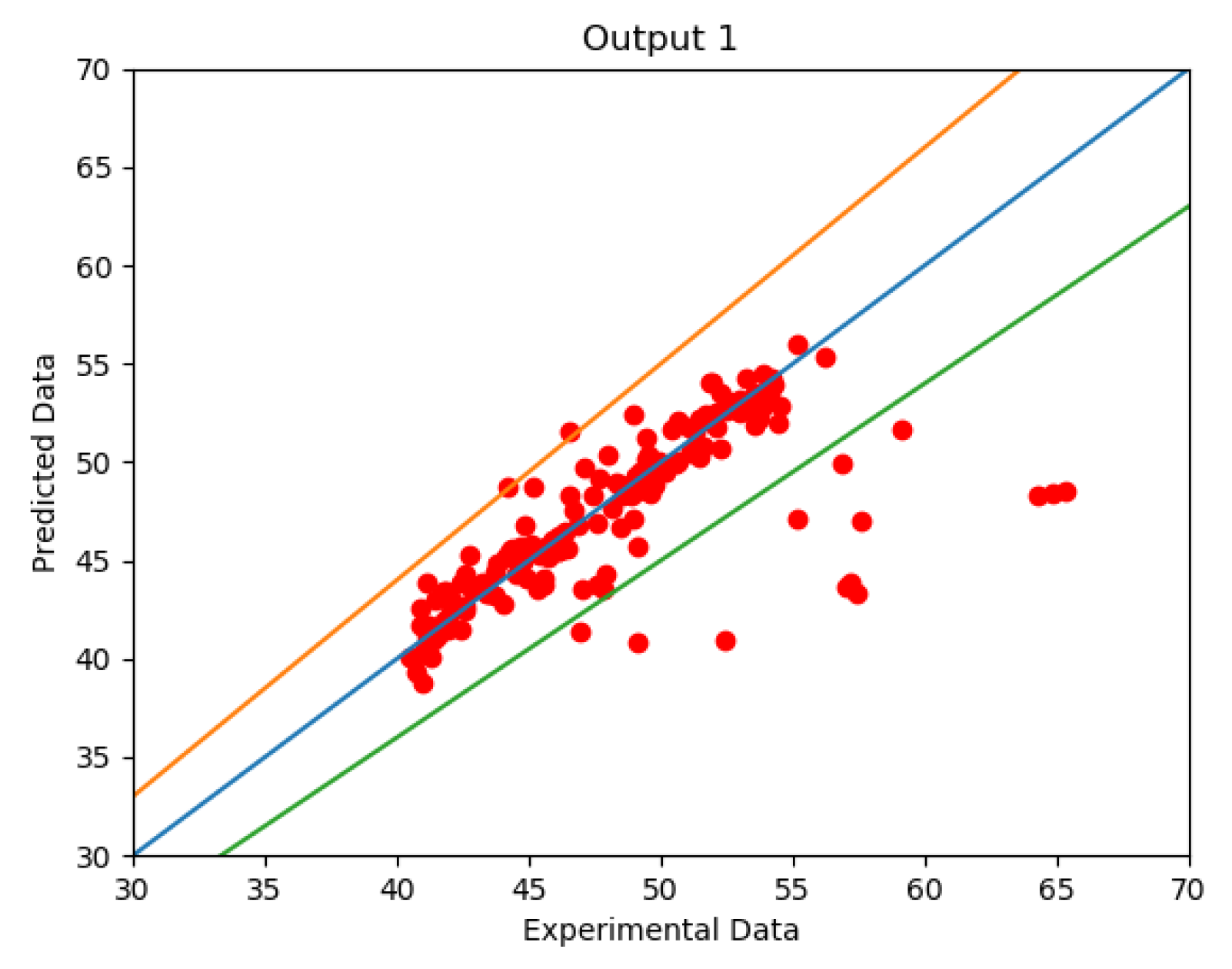Outlet Temperature Prediction of Boiling Heat Transfer in Helical Coils through Artificial Neural Network †
Abstract
:1. Introduction
2. Methods
2.1. Dataset Preparation
2.2. Artificial Neural Networks Model Construction
2.3. Model Accuracy Testing
3. Results and Discussion
3.1. MSE and Accuracy
3.2. Predicted Data
4. Conclusions
Acknowledgments
References
- Tong, L.S.; Tang, Y.S. (Eds.) Boiling Heat Transfer and Two-Phase Flow, 2nd ed.; Taylor and Francis: Abingdon, UK, 1997. [Google Scholar]
- Aria, H.; Akhavan-Behabadi, M.A.; Shemirani, F.M. Experimental Investigation on Flow Boiling Heat Transfer and Pressure Drop of HFC-134a inside a Vertical Helically Coiled Tube. Heat Transf. Eng. 2012, 33, 79–87. [Google Scholar] [CrossRef]
- Kothadia, H.; Prabhu, S.V. Critical Heat Flux in Helical Coils at Low Pressure. Appl. Therm. Eng. 2016, 112, 1223–1239. [Google Scholar]
- Kothadia, H.; Prabhu, S.V. Heat transfer distribution in helical coil flow boiling. Int. J. Heat Mass Transf. 2018, 117, 710–728. [Google Scholar]
- Wang, Y.; Alvarado, J.L.; Terrell, W., Jr. Thermal and flow characteristics of helical coils with reversed loops. Int. J. Heat Mass Transf. 2018, 126, 670–680. [Google Scholar] [CrossRef]
- Xiao, Y.; Hu, Z.; Chen, S.; Gu, H. Experimental study on dryout characteristics of steam-water flow in vertical helical coils with small coil diameters. Nuclear Eng. Design 2018, 335, 303–313. [Google Scholar] [CrossRef]
- Xiao, Y.; Hu, Z.; Chen, S.; Gu, H. Experimental study of two-phase frictional pressure drop of steam-water in helically coiled tubes with small coil diameters at high pressure. Appl. Therm. Eng. 2018, 132, 18–29. [Google Scholar] [CrossRef]
- Rasti, M.; Jeong, J.H. A generalized continuous empirical correlation for the refrigerant mass flow rate through adiabatic straight and helically coiled capillary tubes. Appl. Therm. Eng. 2018, 143, 450–460. [Google Scholar] [CrossRef]
- Dubba, S.K.; Kumar, R. Adiabatic flow characteristics of R-600a inside a helically coiled capillary tube. Appl. Therm. Eng. 2017, 132, 500–507. [Google Scholar] [CrossRef]
- Anas, R.; Xiaoqing, Z. Prediction of oscillatory heat transfer coefficient for a thermoacoustic heat exchanger through artificial neural network technique. Int. J. Heat Mass Transf. 2018, 124, 1088–1096. [Google Scholar]
- Chang, W.; Chu, X.; Fareed, A.F.B.S.; Pandey, S. Heat Transfer Prediction of Supercritical Water with Artificial Neural Networks. Appl. Therm. Eng. 2017, 131, 815–824. [Google Scholar] [CrossRef]
- Kim, D.; Song, K.S.; Lim, J.; Kim, Y. Analysis of two-phase injection heat pump using artificial neural network considering APF and LCCP under various weather conditions. Energy 2018, 155, 117–127. [Google Scholar] [CrossRef]
- Liang, X.; Xie, Y.; Day, R.; Wu, H. Boiling Heat Transfer Prediction in Helical Coils under Terrestrial Gravity with Artificial Neural Network. In Proceedings of the 4th Thermal and Fluids Engineering Conference (TFEC), At Las Vegas, NV, USA, 14–17 April 2019. [Google Scholar]
- Baghban, A.; Kahani, M.; Puia, A.; Ahmadi, M.H. Sensitivity analysis and application of machine learning methods to predict the heat transfer performance of CNT/water nanofluid flows through coils. Int. J. Heat Mass Transf. 2018, 128, 825–835. [Google Scholar] [CrossRef]
- Beigzadeh, R.; Rahimi, M. Prediction of heat transfer and flow characteristics in helically coiled tubes using artificial neural networks. Int. Commun. Heat Mass Transf. 2012, 39, 1279–1285. [Google Scholar] [CrossRef]
- Parrales, A.; Colorado, D.; Diaz, J.; Huicochea, A.; Alvarez-Gallegos, A.A.; Perez, J.A.H. New void fraction equations for two-phase flow in helical heat exchangers using artificial neural networks. Appl. Therm. Eng. 2018, 130, 149–160. [Google Scholar] [CrossRef]
- Gill, J.; Singh, J. Use of Artificial Neural Network approach for depicting mass flow rate of R134a /LPG refrigerant through straight and helical coiled adiabatic capillary tubes of vapor compression refrigeration system. Int. J. Refrig. 2017, 86, 228–238. [Google Scholar] [CrossRef]
- Izadi, M.; Rahimi, M.; Beigzadeh, R. Evaluation of micromixing in helically coiled microreactors using artificial intelligence approaches. Chem. Eng. 2019, 356, 570–579. [Google Scholar] [CrossRef]

© 2020 by the authors. Licensee MDPI, Basel, Switzerland. This article is an open access article distributed under the terms and conditions of the Creative Commons Attribution (CC BY) license (http://creativecommons.org/licenses/by/4.0/).
Share and Cite
Insom, K.; Kamsing, P.; Phisannupawong, T.; Torteeka, P. Outlet Temperature Prediction of Boiling Heat Transfer in Helical Coils through Artificial Neural Network. Proceedings 2019, 39, 16. https://doi.org/10.3390/proceedings2019039016
Insom K, Kamsing P, Phisannupawong T, Torteeka P. Outlet Temperature Prediction of Boiling Heat Transfer in Helical Coils through Artificial Neural Network. Proceedings. 2019; 39(1):16. https://doi.org/10.3390/proceedings2019039016
Chicago/Turabian StyleInsom, Krisana, Patcharin Kamsing, Thaweerath Phisannupawong, and Peerapong Torteeka. 2019. "Outlet Temperature Prediction of Boiling Heat Transfer in Helical Coils through Artificial Neural Network" Proceedings 39, no. 1: 16. https://doi.org/10.3390/proceedings2019039016
APA StyleInsom, K., Kamsing, P., Phisannupawong, T., & Torteeka, P. (2019). Outlet Temperature Prediction of Boiling Heat Transfer in Helical Coils through Artificial Neural Network. Proceedings, 39(1), 16. https://doi.org/10.3390/proceedings2019039016





